From Dante to Dan Brown: 10 things about Hell
- Published
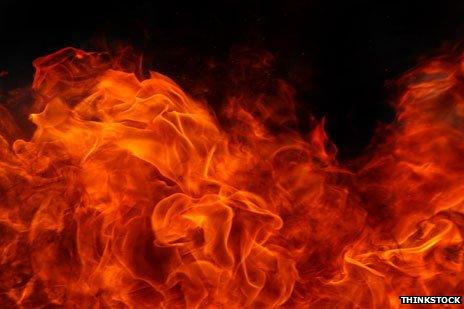
Da Vinci Code author Dan Brown's new book borrows its title and theme from Dante's Inferno, an account of the Italian poet's imagined journey through hell. Writer and church historian Stephen Tomkins gives a 10-point tour of the underworld.
1. Hell is conical
Hell, as Dante described it, consists of nine concentric circles, going deeper each time as they get smaller, towards the centre of the Earth. Which of the nine you are condemned to depends on your sin, with circles devoted to gluttons, heretics and fraudsters. The centre point of the surface of the cone is Jerusalem. The river Acheron runs around hell, separating it from the outside world. Outside hell itself, but still part of the scheme, there are the people who somehow never did anything good or evil in their lifetime. Even they are punished for their neutrality, running round for eternity being stung by wasps while maggots drink their blood.
2. Hell is diverse
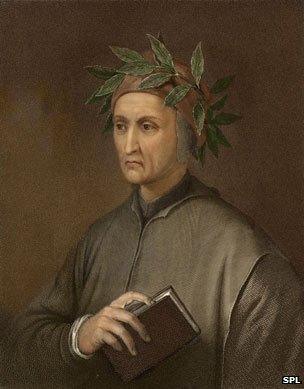
Dante Alighieri, author of La Divina Commedia
The modern cartoon image of Hell, with flames and pitchforks for everyone, is tragically bland compared with medieval depictions. This modern version is probably the legacy of Milton, who in Paradise Lost describes hell as "one great furnace" whose flames offer "no light, but rather darkness visible". Then again, he is setting it in the time of Adam and Eve when its only population is demons, so even his Hell might have livened up a bit later. In the medieval hell explored by Dante and painted by Hieronymus Bosch, punishments are as varied as sin itself, each one shaped to fit the sin punished. In Dante, sowers of discord are cut to pieces, those who take their own lives are condemned to live as mere trees, flatterers swim in a stream of excrement, and a traitor spends eternity having his head eaten by the man he betrayed. In Bosch, one man has a harp strung through his flesh while another is forced to marry a pig in a nun's wimple, and other people are excreted by monsters. This Hell is not a fixed penalty, but the fruition of bad choices made during our lives.
3. Hell is underground - maybe
In the Middle Ages, people generally thought of Hell as being underground, and there were legends of travellers seeing its smoke coming up through holes in the ground. Dante agreed, and because he assumed that the Earth was round, he had Satan at the bottom of Hell, with his waist the centre of Earth's gravity. Milton's Hell, however, is far from Earth. Paradise Lost is set in the time of Adam and Eve when the Earth was still perfect, so it would be incongruous for hell to be in the centre of it. Dante manages to do the whole tour of Hell, purgatory and heaven in less than a week. Meanwhile it takes Milton's Satan nine days just to fall from Heaven to Hell.
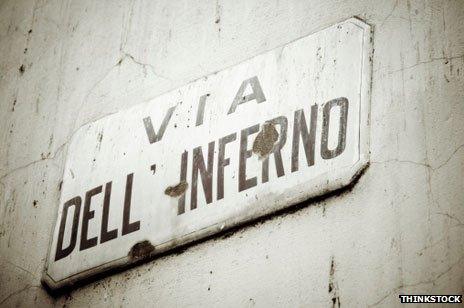
The road to Hell: A street in Florence celebrates the city's most famous writer
4. Hell can freeze over
Actually it can be pretty sweltering, especially in Milton, who describes hills, caves, beaches and bogs of fire. Dante has a river of boiling blood for people guilty of bloodshed, tombs of fire for heretics, and a desert where it rains flakes of fire on blasphemers, usurers and homosexuals. But many of Dante's circles aren't fiery. In the second circle, the lustful are blown about by strong winds, while the gluttons in the third are subjected to sleet and sludge. In the ninth and deepest circle of hell, Satan himself is encased in ice to his waist. For the Devil, it's always a cold day in hell. Even for Milton, beyond the fire plains of Hell there are regions of ice, hail, snow and wind, where the damned are taken on forced excursions. The change offers no respite, as "cold performs th'effect of fire", and in fact the variation only makes things worse.
5. Hell is other people (and they're real)
Hell is full of popes. Milton's Hell doesn't have any people in it yet, though it would surely have an abundance of popes when the time came. But even for ardent Catholics, the Vatican provided a wealth of damnations. Dante finds many popes in hell, including Anastasius II for heresy and Nicholas III for buying episcopal office. The Catholic scholar Erasmus wrote a dialogue called Julius Excluded, where Pope Julius II is rudely turned away from the pearly gates for his many sins. Michelangelo, in his fresco The Last Judgment in the Sistine Chapel, shows real people being pulled down to Hell, including Biagio de Cesena, the Pope's Master of Ceremonies who opposed the artist's depiction of nudity and is shown with a snake eating his genitals. Dante's Inferno includes many people he knew personally, and not just enemies. He is shocked to see his friend and teacher Brunetto Latini suffering the punishment for violence because his sex life did violence to the natural order. At the bottom-most pit of hell, three real people are eternally eaten by a three-headed Satan - the arch traitors Cassius, Brutus and worst of all (because headfirst) Judas. "With six eyes did he weep, and down three chins/Trickled the tear-drops and the bloody drivel."
6. Hell is unreal creatures
Hell is full of creatures from pagan myth. Dante sees centaurs and harpies, the Minotaur, and the three-headed dog Cerberus. Michelangelo includes Charon and Minos, the boatman and judge of the Greek underworld. Even Milton puts Medusa and Hydras there.
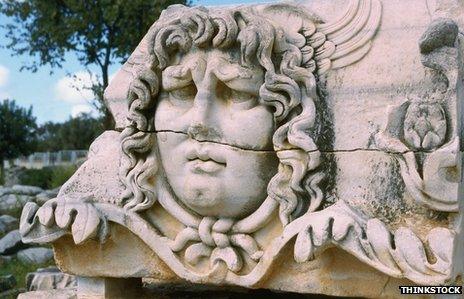
See you in Hell: Greek mythical monster Medusa features in Paradise Lost
7. Hell is pandemonium
Pandemonium ("all the demons"), although it has come to mean noisy chaos, is a word Milton invented for the capital city of hell, where Satan and his followers meet for their infernal parliament. Milton also coined the phrase "all Hell broke loose", which again did not originally refer to noisy chaos, but to demons escaping. When Satan arrives at Eden to tempt Adam and Eve, Gabriel asks him: "Wherefore with thee/Came not all Hell broke loose?"

A scene from Dante's Inferno, illustrated by Gustave Dore (1832-1888)
8. Hell is gated
Dante's gate is famously inscribed "Abandon all hope, ye who enter here". Less famously, this is only the last of a nine-line inscription, which includes the claim that the realm within was created by "the highest Wisdom and the primal Love". In Paradise Lost there are nine gates, three of brass, three of iron, and three of adamantine rock, and they are guarded by Sin, Death and the ever-barking hounds of Hell.
9. Hell isn't all that interested in sex
Christianity may have a bad name for obsession with people's sex lives, but sex doesn't feature very prominently in the behaviour punished in Hell. Admittedly Brunetto Latini is treated harshly in the seventh circle for "unnatural" sex, but mere sins of lust are dealt with in the second circle (the first being limbo, a pretty nice place for unbaptised babies and sinless non-Christians) making it the least of sins.
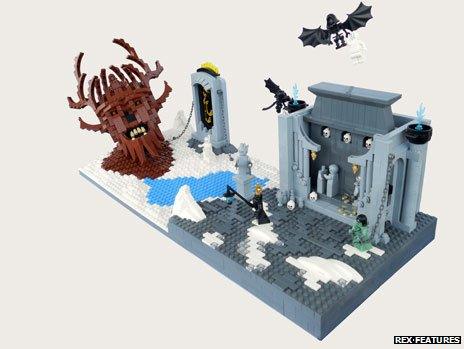
Romanian artist Mihai Marius Mihu spent seven months and 400,000 bricks recreating Dante's Inferno in Lego - this scene is the innermost circle of Hell
10. Hell isn't all that Biblical
Very few of these ideas are from the Bible. The Bible does refer to Hell and its fires, but more of the details in Dante are drawn from Greek and Roman myths, and the vast majority are the creation of medieval Western imagination. Eastern Christian artists never shared their interest, and even in the West it was a late development - the doctrine of perpetual torment was propounded by the Lateran Council of 1215, just a century before Dante wrote. In modern times Christians have become increasingly sceptical about Hell. There are 622 verses in the Bible (in the New International Version) which mention Heaven, and 15 that mention Hell.
You can follow the Magazine on Twitter, external and on Facebook, external